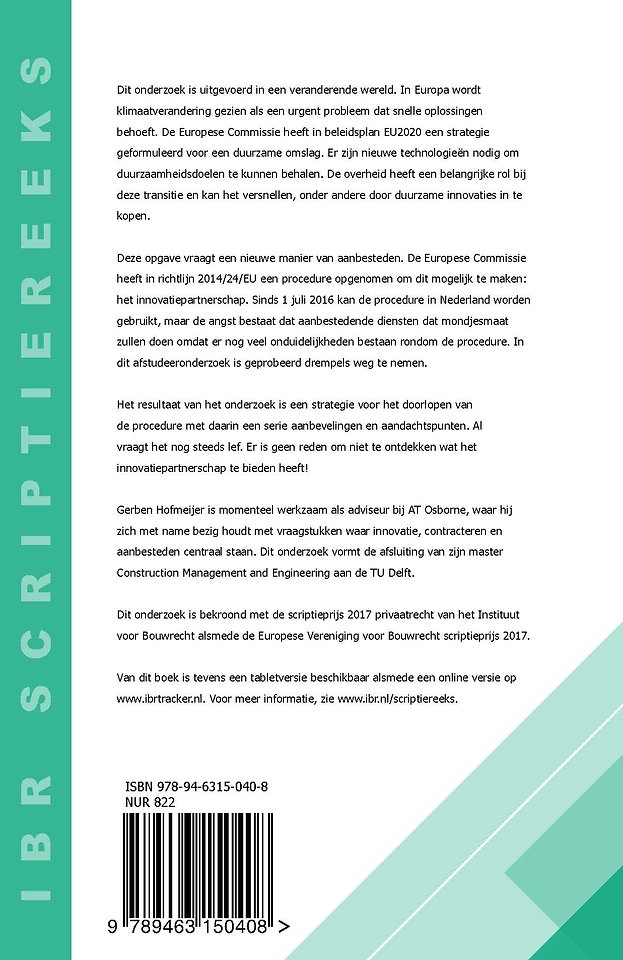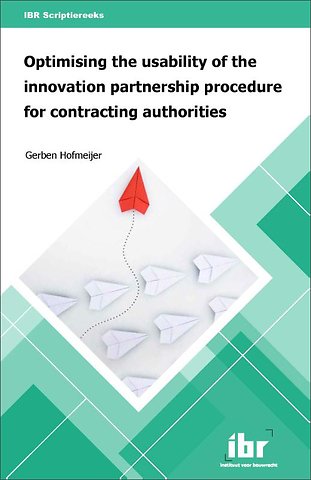Optimising the usability of the innovation partnership procedure for contracting authorities
Samenvatting
Dit onderzoek is uitgevoerd in een veranderende wereld. In Europa wordt klimaatverandering gezien als een urgent probleem dat snelle oplossingen behoeft. De Europese Commissie heeft in beleidsplan EU2020 een strategie geformuleerd voor een duurzame omslag. Er zijn nieuwe technologieën nodig om duurzaamheidsdoelen te kunnen behalen. De overheid heeft een belangrijke rol bij deze transitie en kan het versnellen, onder andere door duurzame innovaties in te kopen.
Deze opgave vraagt een nieuwe manier van aanbesteden. De Europese Commissie heeft in richtlijn 2014/24/EU een procedure opgenomen om dit mogelijk te maken: het innovatiepartnerschap. Sinds 1 juli 2016 kan de procedure in Nederland worden gebruikt, maar de angst bestaat dat aanbestedende diensten dat mondjesmaat zullen doen omdat er nog veel onduidelijkheden bestaan rondom de procedure. In dit afstudeeronderzoek is geprobeerd drempels weg te nemen.
Het resultaat van het onderzoek is een strategie voor het doorlopen van de procedure met daarin een serie aanbevelingen en aandachtspunten. Al vraagt het nog steeds lef. Er is geen reden om niet te ontdekken wat het innovatiepartnerschap te bieden heeft!
Gerben Hofmeijer is momenteel werkzaam als adviseur bij AT Osborne, waar hij zich met name bezig houdt met vraagstukken waar innovatie, contracteren en aanbesteden centraal staan. Dit onderzoek vormt de afsluiting van zijn master Construction Management and Engineering aan de TU Delft.
Dit onderzoek is bekroond met de scriptieprijs 2017 privaatrecht van het Instituut voor Bouwrecht alsmede de Europese Vereniging voor Bouwrecht scriptieprijs 2017.
Trefwoorden
Specificaties
Inhoudsopgave
Abbreviations xi
Managementsamenvatting 1
Executive summary 3
1 Introduction
1.1 Topic 5
1.1.1 Context 5
1.1.2 Motive 5
1.1.3 Problem 6
1.1.4 Objective 6
1.2 Research questions 7
1.3 Scope 7
1.4 Structure of the report 8
2 Research methodology
2.1 General 9
2.2 Literature study 10
2.2.1 Porter’s five forces model 10
2.3 Field research 11
2.3.1 Preparation 11
2.3.2 Interviews 11
2.3.3 Grounded theory 12
2.3.4 Questionnaire 12
2.4 Analysis 13
2.4.1 SWOT 13
2.4.2 SWOT/TOWS 14
2.4.3 Expert panel 14
2.5 Conclusions and recommendations 15
2.5.1 Validation panel 15
3 Literature study
3.1 Public procurement in The Netherlands 17
3.1.1 Definition 17
3.1.2 The necessity of procurement law: basic principles 18
3.1.3 Scope of procurement law 18
3.1.4 From European Committee to Dutch legislation 19
3.1.5 Tendering procedures 19
3.1.6 Tendering process steps 21
3.1.7 Summary 23
3.2 The innovation partnership procedure 24
3.2.1 The innovation partnership in the European directive 24
3.2.2 Comments on the innovation partnership in the directive 25
3.2.3 The innovation partnership in Dutch law 26
3.2.4 Comments on the innovation partnership in the Tendering Act 27
3.2.5 Visualisation of the innovation partnership procedure 28
3.3 Choosing a tendering procedure 28
3.3.1 Often used procedures 29
3.3.2 Determinants of influence to the choice of tendering procedures 30
3.3.3 Implications for this research 31
3.4 Product innovation in public construction projects 32
3.4.1 Introduction 32
3.4.2 Definition 32
3.4.3 Product innovation 32
3.4.4 Types of product innovation 33
3.4.5 Innovation phases 34
3.4.6 Diffusion of innovations 35
3.4.7 Demand-pull and technology-push in construction context 37
3.4.8 Summary 37
3.5 External factors impacting the innovation partnership 38
3.5.1 New entrants 39
3.5.2 Substitutes 39
3.5.3 Contractors 40
3.5.4 Contracting authorities 40
3.5.5 Alternatives 41
4 Theoretical SWOT analysis results
4.1 T-SWOT overview 43
4.2 Strengths 43
4.3 Weaknesses 44
4.4 Opportunities 45
4.5 Threats 46
4.6 Questionnaire 47
4.6.1 Respondents 47
4.6.2 Questionnaire data 48
4.6.3 Questionnaire findings 49
5 Field research
5.1 Interviewees 51
5.2 Results interviews 51
5.3 Other activities 52
6 Practical SWOT analysis results
6.1 P-SWOT overview 53
6.2 Expert panel 53
6.3 Strengths 54
6.4 Weaknesses 55
6.5 Opportunities 55
6.6 Threats 57
7 SWOT/TOWS analysis results
7.1 SWOT/TOWS overview 59
7.2 Weakness / Threat strategy 60
7.3 Weakness / Opportunity strategies 61
7.4 Strength / Threat strategies 61
7.5 Strength / Opportunity strategies 62
8 Conclusions 65
9 Recommendations 67
10 Discussion
10.1 Interpretation 75
10.2 Method 75
10.3 Further research 76
References
Appendix A: Questionnaire 83
Appendix B: Overview of determinants 87









